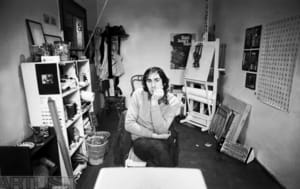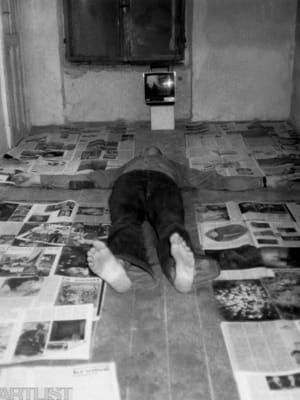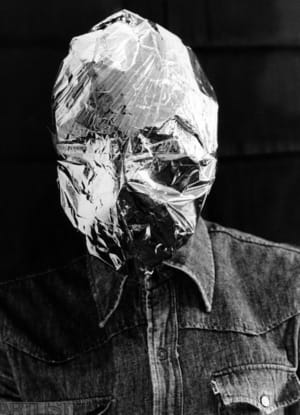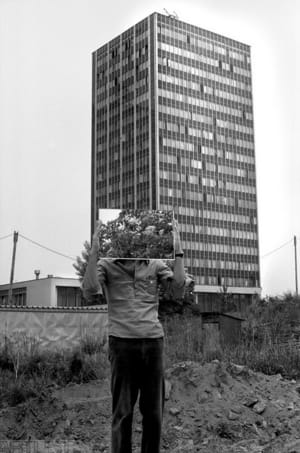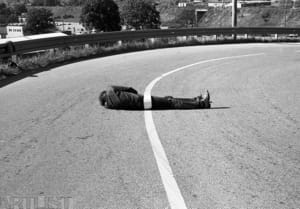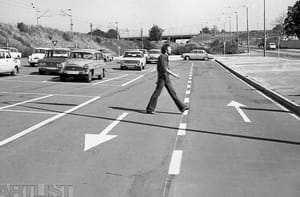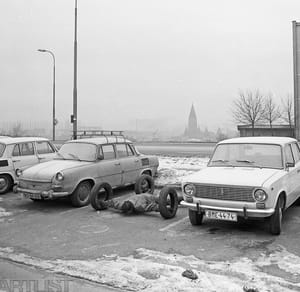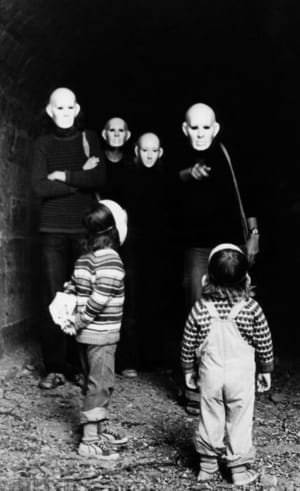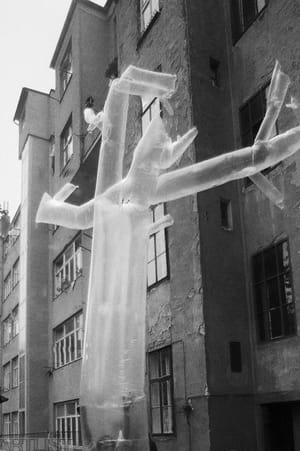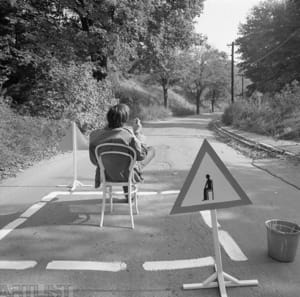- First Name
- Vladimír
- Surname
- Ambroz
- Born
- 1952
- Birth place
- Brno
- Place of work
- Brno
- Keywords
- CSU Library
- ↳ Find in the catalogue
About artist
During the latter half of the 1970s Vladimír Ambroz was a member of the Brno art scene operating outside the official institutions. His performances, in the parlance of that time “actions”, most often took place in Brno. Some possessed the character of private collective events for which he provided a framework in the form of situation or props. The course of the event then depended on the reaction and improvisation of the participants and was documented by means of photography and film. In the latter half of the 1970s the role of the direct audience or participants declined, and many events were created only for the notional audience of the photographic documentation.
In his events, Ambroz intuitively developed the logic of experimental art of the 1970s. However, his works were also an expression of an alternative to the official reality of that time. His circle of friends included Miloslav Sonny Halas and Marian Palla, who were involved in similar activities on the interface of life and art. After 1976 Ambroz learned from the international journal Flash Art about the existence of the Prague performers Petr Štembera, Karel Miler, Jan Mlčoch, etc. He struck up contact with them that was to prove inspiring and grew into personal friendships and the organisation of joint festivals. One of the important events of this kind was the meeting that took place in Ambroz’s studio in December 1980. It was here that Petr Štembera undertook his last performance in public, in which Milan Kozelka and Vladimír Ambroz played an active role. Individual performances were filmed on a borrowed video camera, which in the context of Czech art performance was a unique form of record. Unfortunately all that remains of the film are some stills.
Ambroz’s work from the late 1970s dissolves the boundary between art and life and is open to conceptual tendencies. It reflects general civilisational themes and reacts to the atmosphere of the culmination of normalisation. One example is a series of performances in which the artist confronts a horizontal traffic signpost. By means of lines he isolates himself from his surroundings, walks unambiguously in the opposite direction to the arrows, or places a dividing line on his body and riskily places himself in the middle of the highway. His fascination with the media, especially television, had a similarly critical albeit ironic content. In TV Look (1977) he and some friends watched television with sunglasses on and the sound turned down. In Mediaman (1980) he styled himself as a martyr of the media, and in TV Piece he voluntarily watched an entire day’s broadcasting by Czech TV without a break.
Within the context of Czechoslovak performance, Ambroz’s work laid a unique emphasis on the expression of the photographic documentation, most often created in collaboration with Marie Kratochvílová and Miroslav Ambroz. The aim was not only to record the event, but also to create a meaningful image, the effect of which was as close as possible to the procedures of art or conceptual photography. The photographs were often taken on the basis of a carefully thought-out composition. His interest in photography culminated in events in which, with the aid of mirrors or mirror film, he gave consideration to the reflection of reality, knowledge and subjective embodiment of the surrounding world. However, many of these works remained unexhibited during his life.
In the late 1970s/early 80s, Ambroz worked on a range of mostly unfinished architectural installations or situations that have survived in the form of drawings or textual scripts and that reflect the hopelessness of the Cold War climate, which seemed headed for the mutual assured destruction of nuclear war. After 1981 Ambroz, like many other Czechoslovak artists working in a similar field, brought an end to his performance activities and, with a few exceptions, pursued only his architectural work.
- Author of the annotation
- Tomáš Pospiszyl
- Published
- 2018
CV
Studium: 1972–1978 Fakulta architektury VUT Brno
1968–1972 gymnázium v Mikulově
Pracovní zkušenosti: od 1990 architektonická tvorba v jím založené společnosti amos design 1978–1990 architekt výstavních expozic pro Brněnské veletrhy a výstavy 1978–1989 spolupráce s Československou televizí jako grafik a architekt 1975–1990 návrhy plakátů a obalů gramofonových desek pro rockové a folkové skupiny 1974–1976 jevištní technik v Divadle na Provázku, Brno
Exhibitions
- Solo exhibitions
-
2018
Vladimír Ambroz: Akce, Dům fotografie, Galerie hlavního města Prahy
1982
Activity, Klub Křenová, Brno
- Group exhibitions not included in ARTLIST.
-
2013
Navzájem, společenství 70. a 80 let, tranzitdisplay, Praha, Dům umění města Brna, Brno
1996
Umění zastaveného času, České muzeum výtvarných umění, Praha, Moravská galerie, Brno, Galerie výtvarného umění, Cheb
1991
Umění akce, Mánes, Praha
1987
Divadlo v pohybu III, Divadlo Na Provázku, Brno
1986
V čase, Galerie G 4, Cheb, Výstavní síň Fotochema, Praha
1983
Keramika, Klub Křenová, Brno
1979
Miesca i chwile, Foto Medium Art, Wroclaw, Polsko
1979
Strom, Dům pánů z Kunštátu, Brno
1978
Photography as Art/Art as Photography, Gesamthochschule Kassel, Fotoforum, Německo
1977
Projects and Performances, Czechoslovakia / Poland, Hallwalls Gallery Buffalo, USA
1977
Media Practice, Ai Gallery, Tokyo, Japonsko
- Collections
- Galerie hlavního města Prahy Uměleckoprůmyslové muzeum Praha Moravská galerie v Brně Muzeum města Brna, Muzeum umění Olomouc
Monography
- Monography
2017
Tomáš Pospiszyl (ed.), Vladimír Ambroz, Akce/Actions, BiggBoss Books, Praha 2014
Pavlína Morganová, Czech Action Art, Karolinum, Praha 2013
Barbora Klímová, Navzájem, trazit.cz, Praha, FaVU, Brno 2006
Barbora Klímová, Replaced, vlastní náklad, Brno 1996
Pavlína Morganová, Akční umění 60. a 70. let, Votobia, Olomouc

